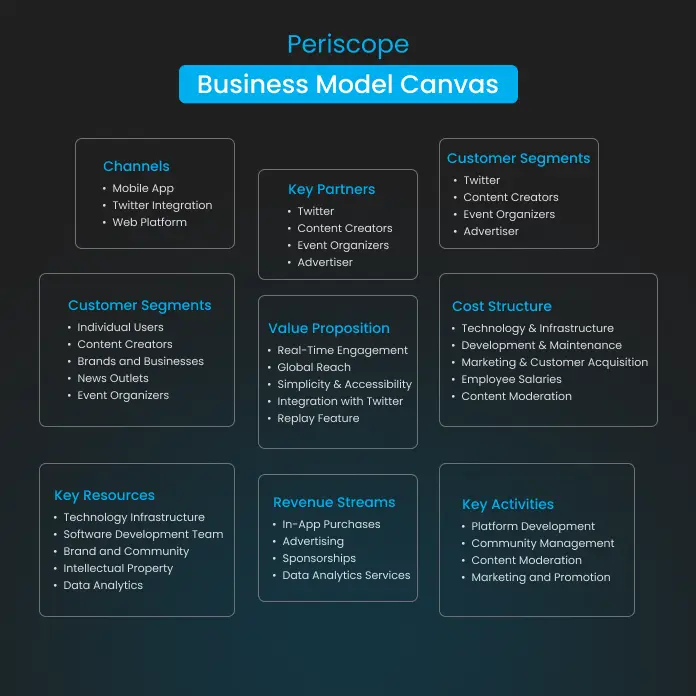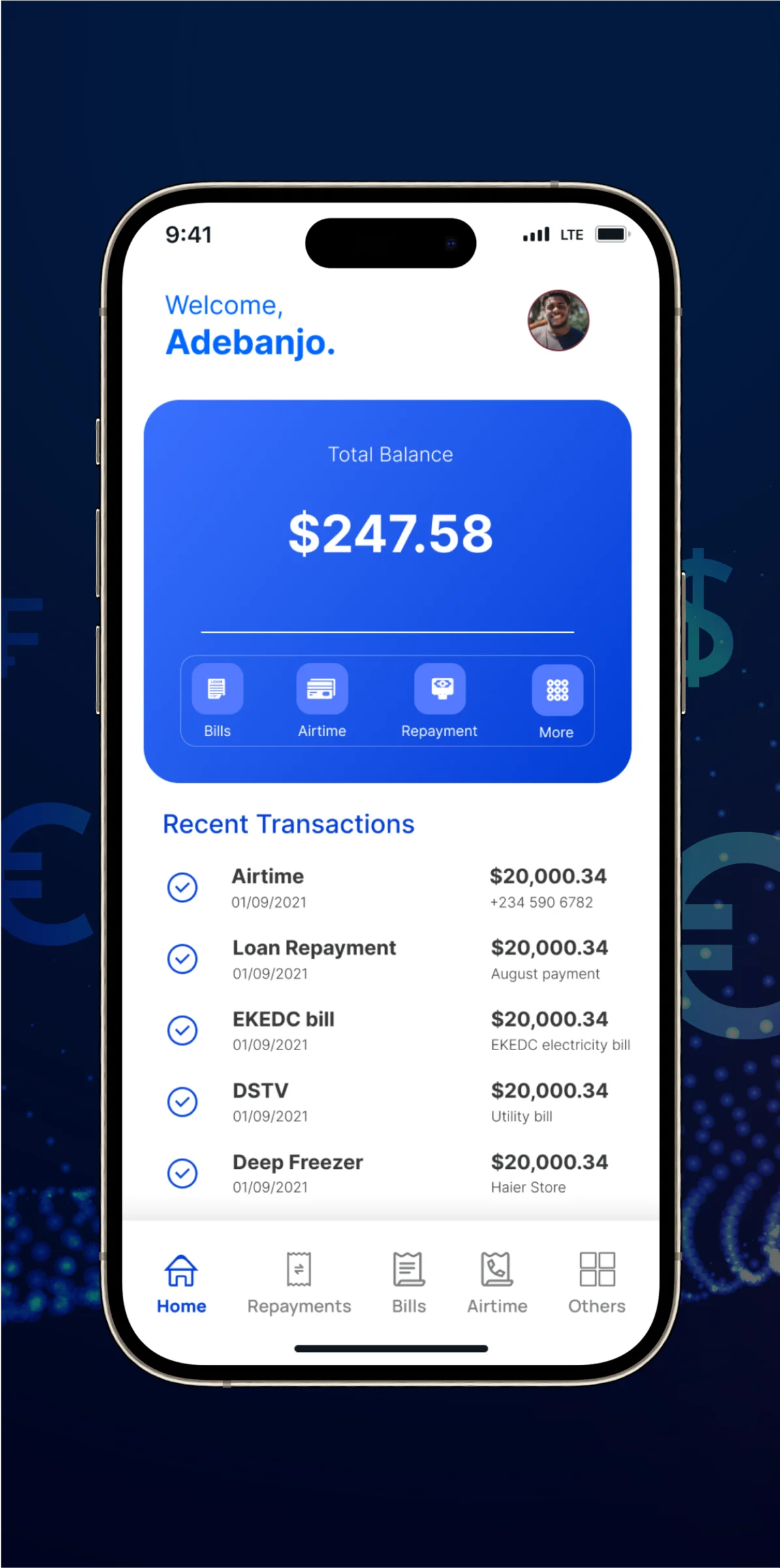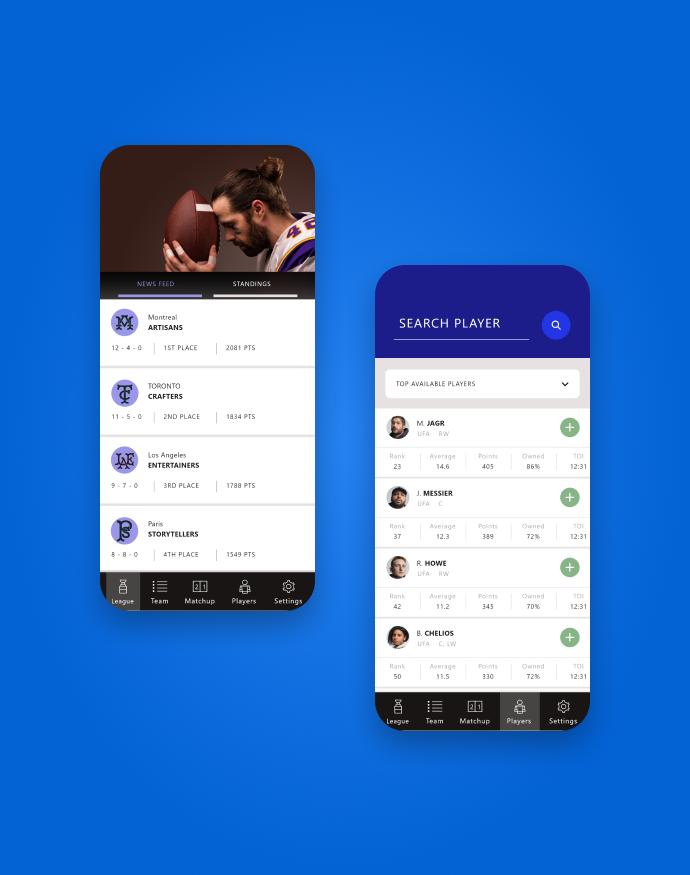- What Made Periscope Appealing?
- How Does Periscope Work? Business Model
- Live Streaming Platform's Market Stats
- Development Steps Of A Live-Streaming App Like Periscope
- How Much Does It Cost To Build An App Like Periscope?
- Why Periscope Failed, And Now What?
- Future Trends In Live Streaming Apps
- Conclusion
- Develop A Feature Rich Live Streaming App With Ideausher
- FAQs

Remember Periscope? The live-streaming app that exploded in popularity a few years back? In fact, Periscope hit 10 million users in just four months! This incredible growth shows the demand for live-streaming platforms and how much users like connecting in real-time.
Live streaming is now a key tool for influencers, brands, and content creators to reach their followers. Major platforms like Facebook Live, Instagram Live, and YouTube Live have all added live-streaming features inspired by Periscope’s success. But what exactly made Periscope tick?
In this blog, we’ll explore the rise and fall of Periscope, offering a detailed look at how it worked and what set it apart. We’ll delve into its unique business model, the features that drove its initial success, and the factors that led to its decline. By the end, you’ll gain valuable insights into the life cycle of the popular live-streaming app, providing lessons for developing your own successful live-streaming platform.
- What Made Periscope Appealing?
- How Does Periscope Work? Business Model
- Live Streaming Platform’s Market Stats
- Development Steps Of A Live-Streaming App Like Periscope
- How Much Does It Cost To Build An App Like Periscope?
- Why Periscope Failed, And Now What?
- Future Trends In Live Streaming Apps
- Conclusion
- Develop A Feature Rich Live Streaming App With Ideausher
- FAQs
What Made Periscope Appealing?
Periscope quickly gained popularity due to its ability to provide real-time interaction between broadcasters and viewers. This made an engaging and dynamic user experience. Simplicity and accessibility were key – anyone could become a broadcaster with just a phone and the app. Periscope’s appeal stemmed from a combination of factors:
1. Live and in the Moment
The app offered a real-time experience. Unlike pre-recorded videos, live streams brought a sense of immediacy and authenticity. You were seeing things unfold as they happened, fostering a sense of connection with the broadcaster.
2. Ephemeral Content
Periscope’s streams disappeared after a set time, creating a sense of urgency and exclusivity. Unlike pre-recorded content that could be watched anytime, live streams offered a “now or never” experience that kept viewers engaged.
3. Low Barrier to Entry
Anyone could become a broadcaster with just a smartphone and the app. This democratized content creation allows for a broader range of voices and ideas to be shared. Periscope also enabled users to reach a global audience instantly. The app featured a map view where users could see live broadcasts from around the world, promoting a sense of global community and connectivity.
4. Interactive Features
Periscope offered features like comments and hearts, allowing viewers to interact directly with broadcasters in real-time. This fostered a sense of community and made viewers feel like they were part of the experience.
5. Discovery and Exploration
The app made it easy to discover new live streams based on location and trending topics. This fueled a sense of exploration and allowed users to stumble upon interesting content they might not have otherwise found.
How Does Periscope Work? Business Model
Periscope allows users to start a live broadcast from their smartphones. Viewers could join the broadcast in real-time, interact through comments, and send “hearts” to show appreciation. The app also offered replay options, allowing broadcasts to be viewed for up to 24 hours after the live stream ended. Integration with Twitter meant that users could notify their Twitter followers about ongoing live streams, expanding the audience and enhancing engagement.

Periscope’s user-centric approach and clever business model fueled its success. Here’s a breakdown of its key components:
Channels
The app reached its audience through a few main channels: a mobile app, integration with Twitter, and a website. This made it easy for users to access live streams on their smartphones or computers.
- Mobile App: Periscope’s primary channel was its user-friendly mobile application, available on iOS and Android. This app allowed anyone to broadcast and view live streams.
- Twitter Integration: Integration with Twitter, Periscope’s parent company, was a key channel. It allowed users to share their live streams with their Twitter followers, significantly expanding reach and engagement.
- Web Platform: While the primary focus was on mobile, users could also view live streams on Periscope’s website. Broadcasting, however, remained primarily an app function.
Key Partners
The app worked closely with several important partners. Being owned by Twitter helped a lot, giving it access to millions of Twitter users. It also partnered with content creators, event organizers, and advertisers to grow its reach and improve its service.
- Twitter: As Periscope’s parent company, Twitter provided a crucial partnership. It offered a massive user base and integration capabilities, significantly enhancing Periscope’s reach and visibility.
- Content Creators: Influencers, celebrities, and brands who used the platform to connect with their audiences were essential partners. Their content creation fueled user engagement.
- Event Organizers: Live events, conferences, and shows that used Periscope for real-time broadcasting to a wider audience were valuable partners.
- Advertisers: Brands and businesses that advertised on the platform to reach a broad, engaged audience contributed to the potential revenue model.
Value Proposition
Periscope’s main appeal was its ability to let users engage in real-time with live video. It was easy to use, had a global reach, and integrated well with Twitter. Also, features like being able to replay broadcasts added extra value by extending the life of each stream.
- Real-Time Engagement: Periscope offered a unique experience – live video with real-time interaction. Users could broadcast live videos and engage with their audience through comments and “hearts.”
- Global Reach: It broke geographical barriers. Users could connect with a global audience instantly, expanding the potential reach of their content and experiences.
- Simplicity and Accessibility: The user-friendly app made live broadcasting accessible to anyone with a smartphone. This low barrier to entry fueled user growth.
- Additional Features: Integration with Twitter and replay functionality for broadcasts (up to 24 hours) all contributed to a more engaging and valuable user experience.
Customer Segments
A variety of people and groups used Periscope. This included everyday users who wanted to share live moments, influencers and content creators looking to connect with fans, brands, and businesses for marketing, news outlets for live reporting, and event organizers broadcasting live events.
- Individual Users: Casual users who want to share live moments with friends and followers. This segment likely made up a significant portion of the user base.
- Content Creators: Influencers and bloggers used live streaming to connect with their audience in a more personal and interactive way. Periscope provided a valuable tool for audience engagement.
- Brands and Businesses: Companies used Periscope for various purposes, including marketing campaigns, live event broadcasts, and customer engagement initiatives.
- News Outlets: Media organizations leveraged Periscope to broadcast live news events and updates, offering viewers a real-time perspective.
- Event Organizers: Event hosts used Periscope to reach a wider online audience, enhancing the reach and impact of their events.
Cost Structure
Running Periscope involved several costs. These included maintaining the technology for streaming, developing and updating the app, marketing to attract users, paying employees, and moderating content to ensure safety and quality.
- Technology and Infrastructure: Maintaining servers, data storage, and bandwidth for live video streaming was a significant cost factor.
- Development and Maintenance: Ongoing development, updates, and bug fixes for the app required a dedicated team and resources.
- Marketing and Customer Acquisition: Attracting and retaining users involves marketing expenses and, potentially, user acquisition costs.
- Employee Salaries: Costs associated with engineers, developers, marketing, and support staff were essential for maintaining the platform.
- Content Moderation: Ensuring a safe and secure user experience by monitoring live streams requires investment in content moderation processes.
Key Resources
It relied on several critical resources: its technology and servers, a team of skilled developers, a strong brand, proprietary technology, and data analytics tools. These resources were essential for delivering high-quality live streaming and innovating continuously.
- Technology Infrastructure: Robust servers, data centers, and networking capabilities were essential to support the demands of live streaming.
- Software Development Team: A skilled team of engineers and developers was crucial for building, maintaining, and innovating the app.
- Brand and Community: A good brand presence and a thriving community of users and content creators were required for user engagement and platform growth.
- Intellectual Property: Proprietary technology and algorithms for live streaming and user interaction were essential for Periscope’s unique functionality.
- Data Analytics: Tools and capabilities to analyze user behavior were crucial for improving the platform and understanding user needs.
Key Activities
The app focused on a few key activities to keep running smoothly. These included developing the platform, managing its user community, moderating content, and marketing to attract and retain users.
- Platform Development: Continuous improvement and innovation of the live-streaming platform were used to stay competitive and cater to evolving user needs.
- Community Management: Actively engaging with and supporting the user community promoted a positive and interactive environment.
- Content Moderation: Monitoring broadcasts to ensure they met community guidelines and standards ensured a safe and appropriate user experience.
- Marketing and Promotion: Attracting and retaining users involved in various marketing activities, including potentially collaborating with influencers.
Revenue Streams
The live-streaming app made money in a few different ways. This included in-app purchases, advertising, sponsorships, and selling data analytics services. These revenue streams helped sustain the platform and allowed it to continue offering valuable services to users and partners.
- In-App Purchases: Users could purchase features like Super Hearts, a virtual currency used to support broadcasters financially.
- Advertising: Brands could pay to advertise on the platform, reaching a broad and engaged audience.
- Sponsorships: Partnering with brands for sponsored broadcasts and events offered another potential revenue stream.
- Data Analytics Services: Offering insights based on user data to businesses and marketers could have been a future revenue model.
Live Streaming Platform’s Market Stats
According to Custom Market Insights, the live-streaming market is expected to grow significantly, increasing from $90.01 billion in 2024 to $559.63 billion by 2032. This growth leads to a compound annual growth rate (CAGR) of 25.60% during the period from 2024 to 2032. In 2023, the market size was valued at $71.62 billion.
North America is set to lead the live-streaming market, benefiting from its advanced digital infrastructure, widespread internet access, and tech-savvy population.
Additionally, the rising popularity of live streaming for sports and e-sports events has driven market growth in this region.
Development Steps Of A Live-Streaming App Like Periscope
If you’re looking to capitalize on this trend and develop a live-streaming app like Periscope, here’s a roadmap to guide you through the process:
Planning Your Live Stream app
The first step involves defining your app’s niche and target audience. What kind of live-streaming experience do you envision? Will it be a general platform like Periscope, or will it serve to a specific niche like gaming or fitness? Identifying your ideal users is equally important. Understanding their demographics, interests, and live-streaming needs will be crucial for crafting a successful app.
Adding value proposition
Next, focus on crafting a compelling value proposition. What will make your app unique from the crowd? Will it offer unique features, superior video quality, or cater to a specific community? Consider the needs of both broadcasters and viewers. How will your app make creating and watching live streams engaging and valuable for everyone involved?
Building Your App
Once you have a clear vision for your app, it’s time to choose a development approach. There are three main options:
- Native App Development (iOS and Android): This approach offers the best user experience but requires separate development for each platform, potentially increasing development time and costs.
- Hybrid App Development: This combines native and web technologies, offering a faster development process but potentially compromising user experience compared to native apps.
- Web-based App: This is the most accessible option, as users can use it from any device. However, it may lack certain functionalities compared to native apps.
Core functionalities
It is essential and should be prioritized during development. These include high-quality, reliable live video streaming functionality; user management features for registration, login, and profile creation; real-time interaction features like comments, likes, and chat; and discovery and search tools to help users find interesting live streams based on location, trending topics, or followed creators.
Design and User Experience
While functionality is important, don’t neglect design. A user-friendly interface is key. The app should be intuitive and simple to navigate for both broadcasters and viewers. Focus on clean design and clear functionality to enhance user experience and keep users coming back for more.
Monetization Strategies
While Periscope itself didn’t generate direct revenue, you can consider incorporating monetization strategies into your app. Some options include in-app purchases (like virtual gifts), advertising, or subscriptions for premium features.
Launch, Promotion, and Maintenance
Following a well-defined launch strategy is crucial to generate buzz and attract users. Utilize social media marketing, influencer partnerships, and app store optimization to gain visibility for your app. Remember, launching your app is only the beginning. Continuously update your app with the latest features, bug fixes, and security additions to keep users engaged and ensure your app remains competitive in the ever-evolving live-streaming market.
How Much Does It Cost To Build An App Like Periscope?
The cost of building a live-streaming app can depend largely on the features you choose and the development approach you take. Here’s an estimate for the total cost based on the ranges provided:
- Low Range: $90,000 – $140,000
This is a basic app with limited features and potentially compromises in user experience or scalability.
- Mid Range: $130,000 – $180,000
It offers a good balance of features and functionality with a focus on user experience.
- High Range: $180,000+
This caters to feature-rich apps with advanced functionalities, high-quality video streaming, and robust infrastructure.
Detailed cost analysis
| Category | Low Range ($63,000 – $100,000) | Mid Range ($100,000 – $150,000) | High Range ($150,000+) |
| Planning and Design | |||
| Market Research & Planning | $2,000 – $5,000 | $3,000 – $8,000 | $5,000 – $12,000 |
| UI/UX Design | $5,000 – $10,000 | $8,000 – $15,000 | $12,000 – $20,000 |
| App Development | |||
| Backend Development | $15,000 – $25,000 | $20,000 – $35,000 | $30,000 – $50,000+ |
| Frontend Development | $12,000 – $20,000 | $18,000 – $30,000 | $25,000 – $40,000+ |
| Core Features | |||
| User Registration & Login | $2,000 – $4,000 | $3,000 – $5,000 | $4,000 – $8,000 |
| Profile Management | $1,000 – $2,000 | $2,000 – $3,000 | $3,000 – $5,000 |
| Live Streaming Integration | $10,000 – $20,000 | $15,000 – $30,000 | $25,000 – $40,000+ |
| Real-Time Comments & Reactions | $3,000 – $5,000 | $5,000 – $8,000 | $8,000 – $12,000 |
| Push Notifications | $2,000 – $4,000 | $3,000 – $5,000 | $4,000 – $8,000 |
| Geolocation & Map Integration | (Optional) $3,000 – $5,000 | (Optional) $5,000 – $8,000 | (Optional) $8,000 – $12,000 |
| Replay Feature | (Optional) $5,000 – $8,000 | (Optional) $8,000 – $12,000 | (Optional) $12,000 – $15,000 |
| Social Media Integration | $2,000 – $4,000 | $3,000 – $5,000 | $4,000 – $8,000 |
| Advanced Features | |||
| Monetization (In-App Purchases, Ads) | (Optional) $5,000 – $10,000 | (Optional) $8,000 – $15,000 | (Optional) $12,000 – $20,000+ |
| Analytics & Reporting | (Optional) $3,000 – $5,000 | (Optional) $5,000 – $8, |
Important Note: Remember, these are just estimates. The actual cost of your app can be higher or lower depending on your specific needs. It’s crucial to get quotes from experienced app development companies to get a more accurate estimate for your project.
Why Periscope Failed, And Now What?
Periscope, the front-runner of mobile live streaming, launched in 2015 with a bang but ultimately shut down in 2021. Here’s a breakdown of why it fell short:
Competition Surge
Established social media apps such as Facebook and Instagram quickly added live-streaming features. These giants already had massive user bases, making it easier for users to connect and broadcast without needing a separate app. Periscope struggled to compete with this network effect.
Copyright Challenges
Periscope faced issues with users broadcasting copyrighted content, like live sporting events or music concerts. This led to takedown notices and frustrated content creators, ultimately impacting user experience. Copyright infringement also opened Periscope up to legal challenges, further straining resources and hindering innovation.
Unsolved Monetization
The app itself didn’t generate direct revenue. While they explored in-app purchases, such as virtual gifts, to support creators, they never established a sustainable income stream. This financial strain limited Periscope’s ability to invest in new features, marketing, and content moderation, hindering its long-term viability.
Innovation Stagnation
While initially innovative, Periscope failed to keep pace with the evolving live-streaming landscape. New features and functionalities weren’t introduced quickly enough to maintain user engagement. As competitor platforms like Facebook Live and Instagram Live constantly added new features like live Q&A sessions, co-streaming capabilities, and integration with e-commerce tools, Periscope appeared stagnant. This lack of innovation led users to migrate to platforms offering a more dynamic and feature-rich live-streaming experience.
Key Takeaways
- Network Effects are Powerful: Integrating live streaming into existing social media platforms with a large user base proved highly successful. Users didn’t need to download a separate app, increasing convenience and reach.
- Content Moderation is Crucial: A strong content moderation system is essential for live-streaming platforms to prevent copyright infringement and maintain a positive user experience.
- Monetization is Essential: A well-defined and sustainable monetization strategy is key for any app’s long-term success. Periscope’s lack of clear revenue streams limited its ability to invest in growth and innovation.
- Continuous Innovation is Key: The live-streaming landscape is constantly evolving. Platforms need to keep innovating and introducing new features to maintain user engagement and stay ahead of the competition.
Future Trends In Live Streaming Apps
The future of live-streaming apps is exciting and full of potential. Here are some main trends and predictions that will shape the development of these apps:
Enhanced Engagement & Community
One of the most exciting trends is the rise of features that will transform live streams from passive viewing experiences into interactive playgrounds. Live polls, quizzes, and even audience-controlled elements will become commonplace, fostering a dynamic and electrifying atmosphere.
Additionally, social and community features like private streams, group chats, and community events will help creators build strong communities around shared interests.
Immersive Experiences
The future of live streaming promises to blur the lines between the real and virtual worlds. Augmented Reality will overlay virtual objects onto live broadcasts, allowing viewers to see product demonstrations come to life or historical landmarks materialize before their eyes. Virtual Reality will take things a step further, transporting viewers to entirely new environments within a live stream.
AI Personalization & Safety
Artificial intelligence is all set to become a game-changer in live streaming apps. AI can curate personalized livestream recommendations for viewers, ensuring they discover content they’ll truly enjoy. Machine Learning can be used for real-time content moderation and translation, creating a safe and inclusive space for a global audience. This ensures viewers can find content that interests them and participate in a safe environment regardless of their native language.
Monetization & Live Commerce
Get ready for innovative ways for creators to make money and for viewers to spend it. Microtransactions, tiered subscriptions with exclusive perks, and seamless integration with e-commerce platforms for live commerce are just a few possibilities waiting to unfold.
For example, watching a makeup tutorial and being able to purchase the exact products the creator is using directly within the live stream. This integration between live content and shopping creates a frictionless experience for viewers and a new revenue stream for creators.
Niche Content & Business Use
The future of live streaming isn’t a one-size-fits-all approach. Live streaming platforms will cater to specific interests, from bird watching to astrophysics, allowing creators to connect with passionate, like-minded audiences. The business world will also embrace live streaming, utilizing it for company presentations, product launches, and even internal communications. This broader utilization opens doors for creators and businesses alike to interact with their target audiences in new and engaging ways.
Privacy, Regulations & Tech Advancements
With the rise of live streaming, regulations and privacy considerations will become increasingly important. Platforms will need to create a balance between fostering creativity and ensuring responsible content, user safety, and data privacy.
Additionally, advancements in technology like 5G networks will enable higher-quality live streams and smoother viewing experiences and pave the way for even more immersive features. Creators will also have access to better tools for producing high-quality streams, and live streaming apps will work seamlessly across different devices, providing a smooth user experience for everyone.
Conclusion
Periscope’s journey from a popular live-streaming app to its eventual decline provides key insights into the dynamics of the tech industry. Its initial success was driven by innovative real-time video sharing and seamless integration with Twitter, capturing a massive user base eager for new ways to connect and share experiences live. However, increased competition, rapid technological advancements, and the relentless need for innovation contributed to its downfall.
The live-streaming market is currently ripe with opportunities. The exponential growth underscores a booming demand for real-time, interactive content, creating a golden opportunity for businesses to capitalize on this trend.
Don’t miss out on your chance to be part of the next big wave in live streaming. The lessons learned from Periscope’s rise and fall can guide you in building a successful, sustainable platform. The market is expanding rapidly, and now is the time to dive in and innovate before your competitors do. The future of live streaming is bright, and the window to make your mark is open—seize it before it’s too late.
Develop A Feature Rich Live Streaming App With Ideausher
Ready to develop a feature-rich live streaming app and capture the booming market? Partner with IdeaUsher to turn your vision into reality. Our team of veteran developers and designers specializes in creating innovative, user-friendly, and scalable live-streaming solutions tailored to your needs. Whether you want to integrate cutting-edge features like augmented reality, real-time interaction, or advanced monetization options, we’ve got you covered.
Don’t let this golden opportunity pass you by. With the live streaming market set to grow exponentially, there’s no better time to invest in your app’s future. Contact IdeaUsher today, and let’s bring your live-streaming app to life. Innovate with IdeaUsher and stay ahead of the competition!
FAQs
How do you create an app for live streaming?
Creating an app for live streaming involves several key steps. First, conduct market research to identify your target audience and competitors. Next, plan the app’s features, such as user registration, live video broadcasting, real-time comments, and monetization options. Hire a skilled development team to handle the technical aspects, including UI/UX design, backend and frontend development, and quality assurance testing. Finally, launch your app on popular platforms like iOS and Android and continuously update it based on user feedback and technological advancements.
What Software is Used for Live Streaming?
Various software solutions are used for live streaming, each catering to different needs. OBS Studio and XSplit are popular choices for desktop streaming due to their robust features and ease of use. For mobile streaming, platforms like Streamlabs and Wirecast Go are common. These software solutions provide essential tools for encoding, broadcasting, and managing live streams, ensuring a smooth streaming experience for both the broadcaster and the audience.
What is a live-streaming API?
It is a set of programming instructions and standards that enables developers to integrate live-streaming functionalities into their applications. With a live streaming API, developers can enable features such as live video broadcasting, real-time chat, and viewer analytics. These APIs handle complex tasks like video encoding, transmission, and playback, simplifying the development process and ensuring a seamless streaming experience for users.
What Programming Language is Used for Live Streaming?
Several programming languages are used to develop live-streaming applications, depending on the specific needs and platforms. Common languages include JavaScript (with frameworks like Node.js) for real-time functionalities, Swift and Objective-C for iOS apps, and Java and Kotlin for Android apps. Additionally, Python and Ruby are often used for backend development due to their efficiency in handling data processing and server management tasks. Each language offers unique advantages, and the choice often depends on the development team’s expertise and project requirements.












